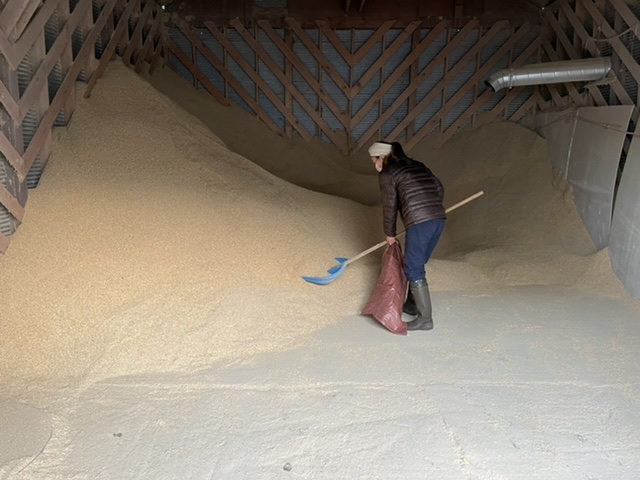
 1
1




![Filename: AB0D290C-ED1F-406B-848C-7F81F9CA0243.jpeg
Description: Ongoing problem [Thumbnail for AB0D290C-ED1F-406B-848C-7F81F9CA0243.jpeg]](/t/122458/a/160978/AB0D290C-ED1F-406B-848C-7F81F9CA0243.jpeg)


 2
2




Silence is Golden
For all your RMH needs:
dragontechrmh.com




Gerry Parent wrote: I think you answered your own question beautifully Peter. All of your observations have been very similar to my own.
In those places that experience expansion and contraction or of dis-similar materials coming together that you would like to seal, a thin layer of ceramic fibre blanket works great. Often goes by the name of ceramic fibre paper.
I’ve also used woodstove gasket rope with good success as well.
![Filename: D5D7F2D4-B3A3-4CEA-AF1D-A9C791C4BEAF.jpeg
Description: [Thumbnail for D5D7F2D4-B3A3-4CEA-AF1D-A9C791C4BEAF.jpeg]](/t/122458/a/160984/D5D7F2D4-B3A3-4CEA-AF1D-A9C791C4BEAF.jpeg)

 1
1





God of procrastination https://www.youtube.com/watch?v=q1EoT9sedqY
 1
1




best regards, Byron
 1
1




Silence is Golden
For all your RMH needs:
dragontechrmh.com




Satamax Antone wrote:Peter, you need to find this, for metal barrels.

https://www.google.fr/search?q=metal+barrel+lid+clamp&tbm=isch
And for your tape, clean with acetone.




Gerry Parent wrote: Yes the band clamp works great. I personally didn’t need one because one of my barrels was slightly smaller than the other and they fit together perfectly with a friction fit.
I secured my rope gasket to one of the barrels with furnace cement. I previously used high heat silicone as well with good results.




Byron Campbell wrote:Hi Peter, Maybe the adhesive had gotten to old, dried out some, on your aluminum tape. I used a generic inexpensive aluminum tape rated for 350°F, and didn't have any trouble with it sticking to both the barrels (painted) and the flu pipe seams (bare metal ducting pipes) in the thermal mass bench.
To seal the main barrel to the lower half-barrel, small strips of aluminum tape are used to hold the rope gasket temporarily in place, then it is completely covered with aluminum tape. The barrel lid "band clamp" goes on over that, and compresses the rope gasket firmly in place.
 1
1




![Filename: B871F1F4-D59B-48FC-900A-9579EA03121E.jpeg
Description: [Thumbnail for B871F1F4-D59B-48FC-900A-9579EA03121E.jpeg]](/t/122458/a/161229/B871F1F4-D59B-48FC-900A-9579EA03121E.jpeg)
![Filename: 75085EAA-DF92-4CC3-90D1-598691677FF9.jpeg
Description: [Thumbnail for 75085EAA-DF92-4CC3-90D1-598691677FF9.jpeg]](/t/122458/a/161230/75085EAA-DF92-4CC3-90D1-598691677FF9.jpeg)
![Filename: A6A55152-A5DD-4418-8F7F-A3B96F3209BC.jpeg
Description: [Thumbnail for A6A55152-A5DD-4418-8F7F-A3B96F3209BC.jpeg]](/t/122458/a/161231/A6A55152-A5DD-4418-8F7F-A3B96F3209BC.jpeg)
![Filename: 4824A179-C81E-4393-9AA7-183E28CCD918.jpeg
Description: [Thumbnail for 4824A179-C81E-4393-9AA7-183E28CCD918.jpeg]](/t/122458/a/161232/4824A179-C81E-4393-9AA7-183E28CCD918.jpeg)
![Filename: 83D05A89-CCAC-4699-A556-B666E2EDD0C6.jpeg
Description: [Thumbnail for 83D05A89-CCAC-4699-A556-B666E2EDD0C6.jpeg]](/t/122458/a/161233/83D05A89-CCAC-4699-A556-B666E2EDD0C6.jpeg)
![Filename: 029422CA-3BCE-40ED-8324-D15A2D4B5BC8.jpeg
Description: [Thumbnail for 029422CA-3BCE-40ED-8324-D15A2D4B5BC8.jpeg]](/t/122458/a/161234/029422CA-3BCE-40ED-8324-D15A2D4B5BC8.jpeg)
 1
1




![Filename: CF38AF97-69A5-4078-9AEF-2FD048AAB51D.jpeg
Description: [Thumbnail for CF38AF97-69A5-4078-9AEF-2FD048AAB51D.jpeg]](/t/122458/a/161236/CF38AF97-69A5-4078-9AEF-2FD048AAB51D.jpeg)
![Filename: F91B5D15-F1B6-45EF-B891-32BCEB09F93E.jpeg
Description: [Thumbnail for F91B5D15-F1B6-45EF-B891-32BCEB09F93E.jpeg]](/t/122458/a/161237/F91B5D15-F1B6-45EF-B891-32BCEB09F93E.jpeg)
![Filename: CF3847EC-2981-4F68-9E98-2F916B3541B8.jpeg
Description: [Thumbnail for CF3847EC-2981-4F68-9E98-2F916B3541B8.jpeg]](/t/122458/a/161238/CF3847EC-2981-4F68-9E98-2F916B3541B8.jpeg)

 1
1




Silence is Golden
For all your RMH needs:
dragontechrmh.com
 2
2




Gerry Parent wrote: Hey Pete I would be very careful with that strainer on the end of the chimney pipe as fly ash will quickly plug it up and you will be back to having smoke in the house again!
Very coarse screening is about all you can get away with to prevent birds and critters from getting down the pipe.
Yes, soot is just a natural byproduct of wood combustion and still needs to be cleaned from pipes every so often.
It is soft, powdery and is removed easily. On the other hand creosote is hard and shiny and is quite difficult to remove.
Great job on the wire tying and homemade wire brush.
BTW ... you must have horseshoes up your butt being able to manifest bricks floating right to your doorstep!
 2
2




![Filename: 8084D164-15C2-4292-A041-FE6BE98C8E8B.jpeg
Description: [Thumbnail for 8084D164-15C2-4292-A041-FE6BE98C8E8B.jpeg]](/t/122458/a/161527/8084D164-15C2-4292-A041-FE6BE98C8E8B.jpeg)
![Filename: 4CFB1607-6D28-4868-8238-900A01B2CC44.jpeg
Description: Store bought goop [Thumbnail for 4CFB1607-6D28-4868-8238-900A01B2CC44.jpeg]](/t/122458/a/161528/4CFB1607-6D28-4868-8238-900A01B2CC44.jpeg)
![Filename: 281C15B8-7137-4BF2-835D-2E902A69BDEE.jpeg
Description: [Thumbnail for 281C15B8-7137-4BF2-835D-2E902A69BDEE.jpeg]](/t/122458/a/161529/281C15B8-7137-4BF2-835D-2E902A69BDEE.jpeg)

![Filename: 830C9B1E-9A80-49EE-85AD-B009053F917A.jpeg
Description: [Thumbnail for 830C9B1E-9A80-49EE-85AD-B009053F917A.jpeg]](/t/122458/a/161531/830C9B1E-9A80-49EE-85AD-B009053F917A.jpeg)
![Filename: FC86E608-5B75-475B-8BB3-22C4117295AF.jpeg
Description: [Thumbnail for FC86E608-5B75-475B-8BB3-22C4117295AF.jpeg]](/t/122458/a/161532/FC86E608-5B75-475B-8BB3-22C4117295AF.jpeg)
![Filename: 2E1F8320-2B3D-4891-A709-94376E14DA81.jpeg
Description: [Thumbnail for 2E1F8320-2B3D-4891-A709-94376E14DA81.jpeg]](/t/122458/a/161533/2E1F8320-2B3D-4891-A709-94376E14DA81.jpeg)
 3
3




![Filename: D035F9B8-0CD5-4B52-8944-D2663CD4F265.jpeg
Description: [Thumbnail for D035F9B8-0CD5-4B52-8944-D2663CD4F265.jpeg]](/t/122458/a/161593/D035F9B8-0CD5-4B52-8944-D2663CD4F265.jpeg)
![Filename: B93E1FD5-295B-44AF-B367-E6D1B1E72BE0.jpeg
Description: [Thumbnail for B93E1FD5-295B-44AF-B367-E6D1B1E72BE0.jpeg]](/t/122458/a/161594/B93E1FD5-295B-44AF-B367-E6D1B1E72BE0.jpeg)





God of procrastination https://www.youtube.com/watch?v=q1EoT9sedqY
 2
2




Satamax Antone wrote:Vacuum cleaner! I do that for flies!
![Filename: D254BE78-9D8A-4922-85B6-37594A2A1940.jpeg
Description: [Thumbnail for D254BE78-9D8A-4922-85B6-37594A2A1940.jpeg]](/t/122458/a/161671/D254BE78-9D8A-4922-85B6-37594A2A1940.jpeg)
 3
3











 1
1




God of procrastination https://www.youtube.com/watch?v=q1EoT9sedqY





 1
1




God of procrastination https://www.youtube.com/watch?v=q1EoT9sedqY

 1
1





God of procrastination https://www.youtube.com/watch?v=q1EoT9sedqY




Satamax Antone wrote:Peter, one thing which crossed my mind.
Crush these dying isolite bricks, mix it with good clay and rice hulls. To pour your feed tube bottom. I would try to put a sacrificial piece of steel over that, for a few days, to fire the "slab"
I wonder if you could wash some of that clay, to make a nice clean one.





 1
1




God of procrastination https://www.youtube.com/watch?v=q1EoT9sedqY





 1
1




Peter Sedgwick wrote:
You never have issues with your IFB in your batchbox floor?
🤙🏽Pete🤙🏿

God of procrastination https://www.youtube.com/watch?v=q1EoT9sedqY




Satamax Antone wrote:
Peter Sedgwick wrote:
You never have issues with your IFB in your batchbox floor?
🤙🏽Pete🤙🏿
My batch hasn't IFB in the batch. But hard firebrick slabs, surrounded by air entrained concrete

![Filename: E5B88261-F92D-4CD7-83CB-2B4EC4B200AD.jpeg
Description: Late night ghetto shop set up [Thumbnail for E5B88261-F92D-4CD7-83CB-2B4EC4B200AD.jpeg]](/t/122458/a/161870/E5B88261-F92D-4CD7-83CB-2B4EC4B200AD.jpeg)






God of procrastination https://www.youtube.com/watch?v=q1EoT9sedqY
 1
1








Satamax Antone wrote:Peter, i'm just using available materials.
The air entrained concrete is called "siporex" here. The refractory slabs are stuff sold in Italy, on the other side of the border from me. 50x50x6cm. Made for pizza ovens. It's a bit expensive. 170 uros of slabs, when i made that one. And the refractory tubes are pieces of schiedel chimneys. I got that cheap at the time. But it's far from perfect. Peter van den berg, on his latest prototype, might have found better. https://donkey32.proboards.com/post/36699/thread




Phil Stevens wrote:Is it possible that salt from soaking in seawater is what's causing it to spall? I'd try soaking the remaining pieces in fresh water, possibly several times, to draw out the salt.
 1
1






 1
1




 2
2




Silence is Golden
For all your RMH needs:
dragontechrmh.com
 2
2




![Filename: 081A83B0-AFF0-4364-A1C2-1798DC5C1AE8.jpeg
Description: [Thumbnail for 081A83B0-AFF0-4364-A1C2-1798DC5C1AE8.jpeg]](/t/122458/a/162222/081A83B0-AFF0-4364-A1C2-1798DC5C1AE8.jpeg)
 2
2




Fox James wrote:I have a cat that likes doing that, my tip is give him some water …

|
The moth suit and wings road is much more exciting than taxes. Or this tiny ad:
The new kickstarter is now live!
https://www.kickstarter.com/projects/paulwheaton/garden-cards
|









